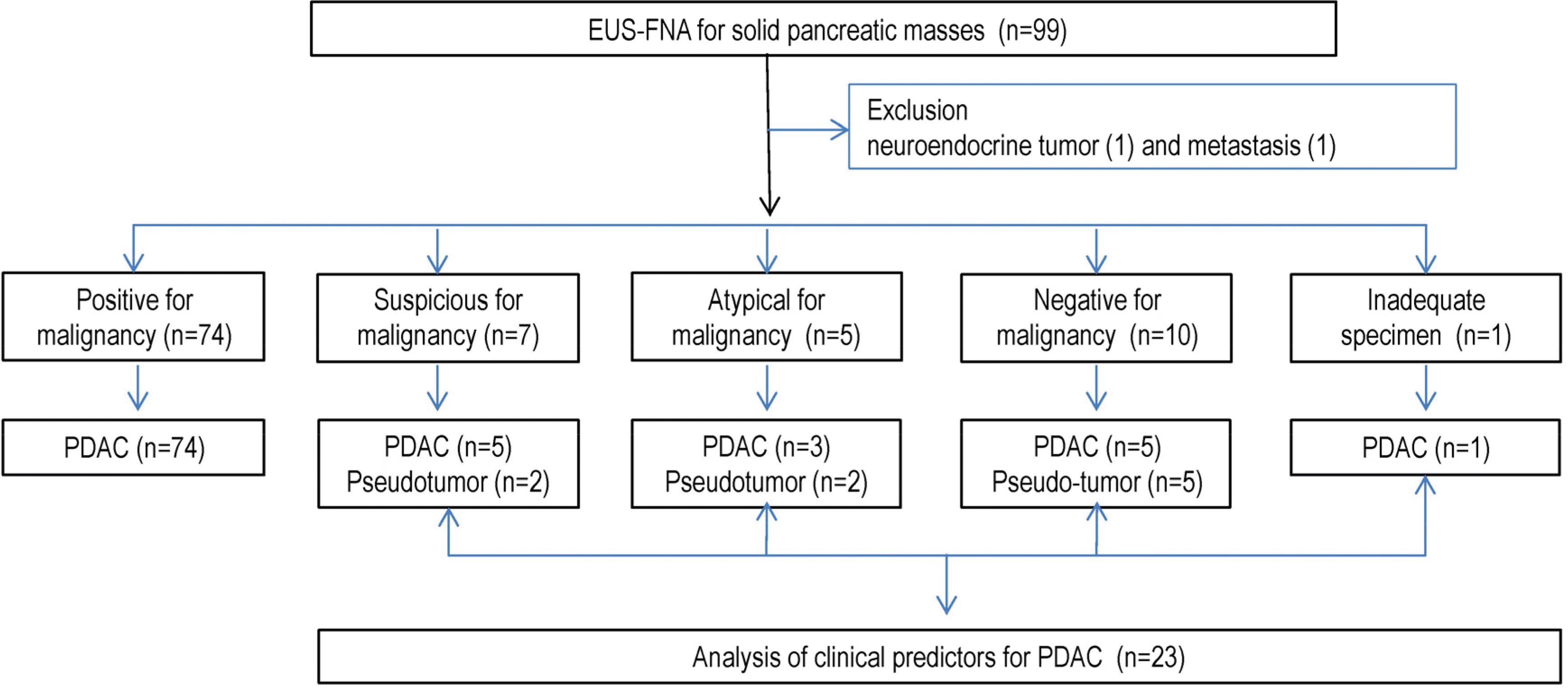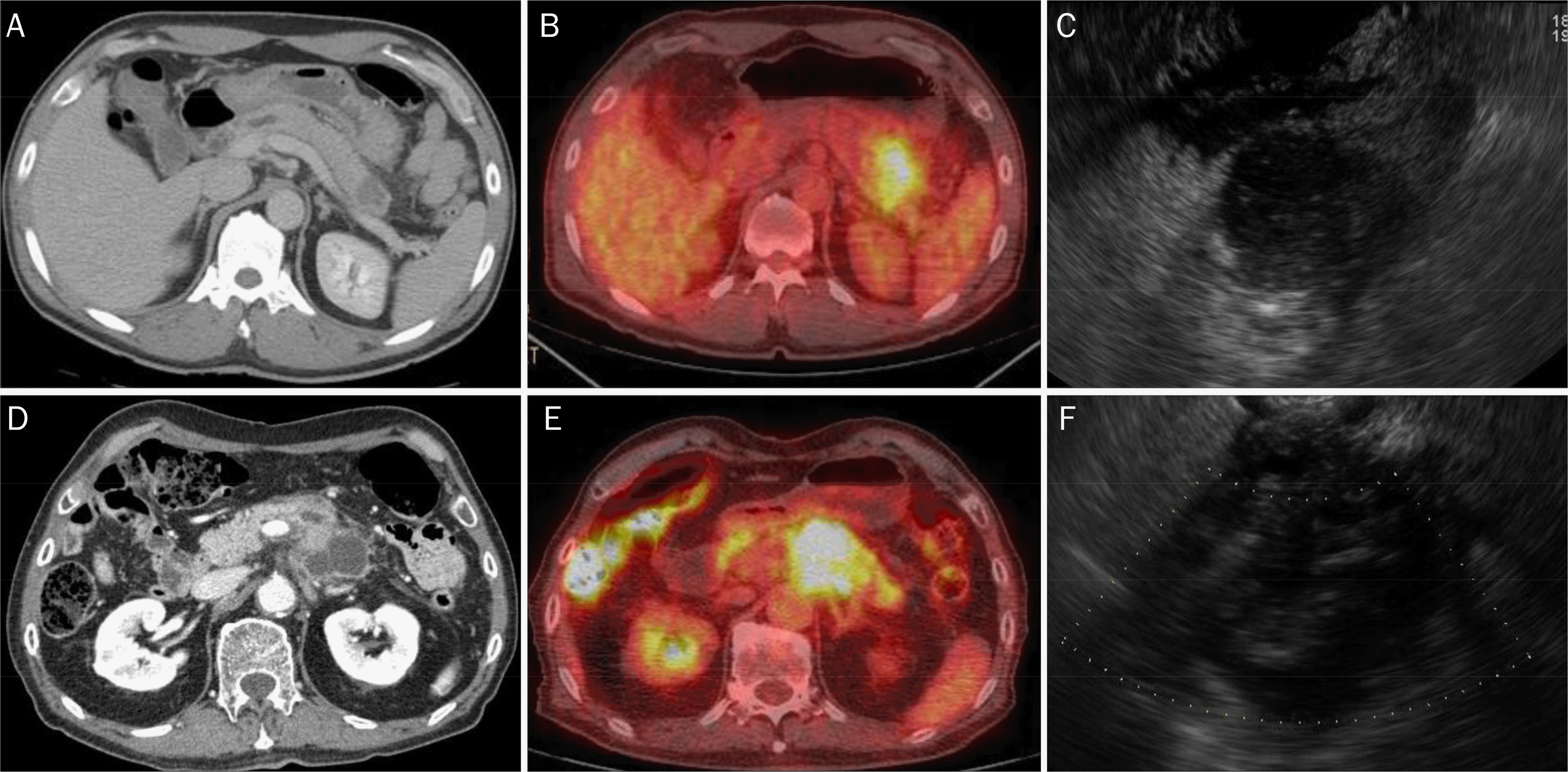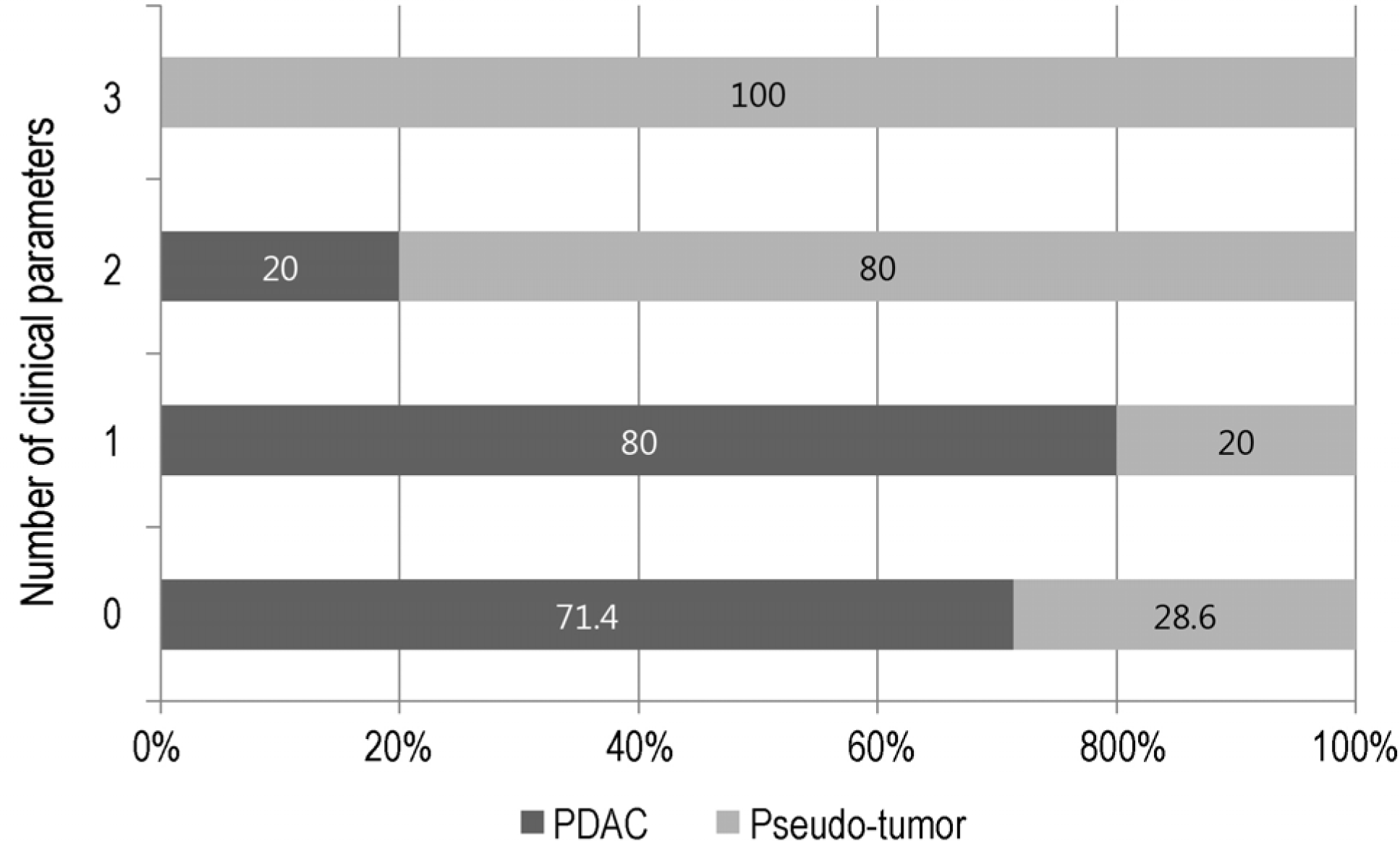Abstract
Background/Aims
This study analyzed the diagnostic accuracy of endoscopic ultrasound-guided fine needle aspiration (EUS-FNA) for pancreatic solid masses in patients with or without chronic pancreatitis as well as the clinical parameters relevant to a malignancy when EUS-FNA was negative or inconclusive.
Methods
A total of 97 patients, who underwent EUS-FNA for solid pancreatic masses over 2 years at a single institution, were evaluated. All patients underwent EUS-FNA for 3–5 passes with 22 or 25 G needles without an on-site cytopathologist. The final diagnosis was obtained by surgery or compatible clinical outcomes for a more than 12 month follow-up. The diagnostic yields in the patients with or without chronic pancreatitis were compared and the histories and laboratory data relevant to pancreatic ductal adenocarcinoma (PDAC) or pseudotumor were analyzed.
Results
The final diagnoses were adenocarcinoma in 88 patients (90.7%) and inflammatory pseudotumor in 9 (9.3%). The results of EUS-FNA were adenocarcinoma (74), suspicious (7), atypical (5), negative (10), and inadequate specimen (1). The diagnostic accu-racies were 76.9% and 91.6% in patients with or without chronic pancreatitis, respectively. Among the 23 cases with non-diagnostic results of EUS-FNA, PDAC was finally diagnosed in 5 out of 7 suspicious, 3 out of 5 atypical, and 5 out of 10 negative cytology cases. The clinical parameters related to a pseudotumor were a history of alcohol consumption and pancreatitis, and normal alkaline phosphatase levels.
References
1. Farrell JJ. Diagnosing pancreatic malignancy in the setting of chronic pancreatitis: is there room for improvement? Gastrointest Endosc. 2005; 62:737–741.

2. Krishna NB, Mehra M, Reddy AV, Agarwal B. EUS/EUS-FNA for abdominal pancreatic cancer: influence of chronic pancreatitis and clinical presentation with or without obstructive jaundice on abdominal characteristics. Gastrointest Endosc. 2009; 70:70–79.
3. Puli SR, Bechtold ML, Buxbaum JL, Eloubeidi MA. How good is abdominal ultrasound-guided fine-needle aspiration in abdominal the correct etiology for a solid pancreatic mass?: a metaanalysis and systematic review. Pancreas. 2013; 42:20–26.
4. Fritscher-Ravens A, Brand L, Knöfel WT, et al. Comparison of abdominal ultrasound-guided fine needle aspiration for focal abdominal lesions in patients with normal parenchyma and chronic pancreatitis. Am J Gastroenterol. 2002; 97:2768–2775.
5. Varadarajulu S, Tamhane A, Eloubeidi MA. Yield of EUS-guided FNA of pancreatic masses in the presence or the absence of chronic pancreatitis. Gastrointest Endosc. 2005; 62:728–736.

6. Eloubeidi MA, Varadarajulu S, Desai S, et al. A prospective abdominal of an algorithm incorporating routine preoperative abdominal ultrasound-guided fine needle aspiration in suspected pancreatic cancer. J Gastrointest Surg. 2007; 11:813–819.
7. Sun B, Yang X, Ping B, He Y, Zhang Z. Impact of inconclusive abdominal ultrasound-guided fine-needle aspiration results in the management and outcome of patients with solid pancreatic masses. Dig Endosc. 2015; 27:130–136.
8. Bang JY, Varadarajulu S. Neoplasia in chronic pancreatitis: how to maximize the yield of endoscopic ultrasound-guided fine abdominal aspiration. Clin Endosc. 2014; 47:420–424.
9. Bloomston M, Bekaii-Saab TS, Kosuri K, et al. Preoperative abdominal antigen 19–9 is most predictive of malignancy in older jaundiced patients undergoing pancreatic resection. Pancreas. 2006; 33:246–249.
10. Tessler DA, Catanzaro A, Velanovich V, Havstad S, Goel S. Predictors of cancer in patients with suspected pancreatic abdominal without a tissue diagnosis. Am J Surg. 2006; 191:191–197.
11. Lee H, Lee JK, Kang SS, et al. Is there any clinical or radiologic feature as a preoperative marker for differentiating mass-forming pancreatitis from early-stage pancreatic adenocarcinoma? Hepatogastroenterology. 2007; 54:2134–2140.
12. Cai QC, Chen Y, Xiao Y, et al. A prediction rule for estimating abdominal cancer risk in chronic pancreatitis patients with focal abdominal mass lesions with prior negative EUS-FNA cytology. Scand J Gastroenterol. 2011; 46:464–470.
13. Alston EA, Bae S, Eltoum IA. Suspicious cytologic diagnostic abdominal in endoscopic ultrasound-guided FNA of the pancreas: fol-low-up and outcomes. Cancer Cytopathol. 2016; 124:53–57.
14. Lee HS, Kim TN, Lee DH, et al. Korean guideline for chronic pancreatitis. Korean J Pancreas Biliary Tract. 2008; 13:38–48.
15. Siddiqui UD, Rossi F, Rosenthal LS, Padda MS, Murali-Dharan V, Aslanian HR. EUS-guided FNA of solid pancreatic masses: a abdominal, randomized trial comparing 22-gauge and 25-gauge needles. Gastrointest Endosc. 2009; 70:1093–1097.
16. Pitman MB, Centeno BA, Ali SZ, et al. Standardized terminology and nomenclature for pancreatobiliary cytology: the Papanicolaou Society of Cytopathology guidelines. Diagn Cytopathol. 2014; 42:338–350.

17. Hewitt MJ, McPhail MJ, Possamai L, Dhar A, Vlavianos P, Monahan KJ. EUS-guided FNA for diagnosis of solid pancreatic neoplasms: a metaanalysis. Gastrointest Endosc. 2012; 75:319–331.

18. Ardengh JC, Lopes CV, Campos AD, Pereira de Lima LF, Venco F, Módena JL. Endoscopic ultrasound and fine needle aspiration in chronic pancreatitis: differential diagnosis between pseudoabdominalal masses and pancreatic cancer. JOP. 2007; 8:413–421.
19. Savides TJ, Donohue M, Hunt G, et al. EUS-guided FNA diagnostic yield of malignancy in solid pancreatic masses: a benchmark for quality performance measurement. Gastrointest Endosc. 2007; 66:277–282.
20. Abdelgawwad MS, Alston E, Eltoum IA. The frequency and cancer risk associated with the atypical cytologic diagnostic category in endoscopic ultrasound-guided fine-needle aspiration abdominal of solid pancreatic lesions: a metaanalysis and argument for a Bethesda system for reporting cytopathology of the pancreas. Cancer Cytopathol. 2013; 121:620–628.
Fig. 1.
Representative images of the pancreatic cytology (papanicolaou staining, magnification ×400). (A) Positive for a malignancy. (B) Suspicious for a malignancy. (C) Atypical cells. (D) Negative for a malignancy.

Fig. 2.
Flow chart of the diagnostic process. Of the 99 patients who underwent EUS-FNA, each patient with a neuroendocrine tumor and metastasis on the pancreas was excluded. Twenty-three patients with negative or non-diagnostic EUS-FNA were included in the analysis of the clinical parameters relevant to pancreatic cancers or pseudotumors. EUS-FNA, endoscopic ultrasonography guided fine needle aspiration; PDAC, percentages of pancreatic ductal adenocarcinoma.

Fig. 3.
Representative images of a pseudotumor (A-C) and pancreatic adenocarcinoma (D-F) in the setting of chronic pancreatitis. (A, D) Abdominal computed tomography scan. (B, E) Positron emission tomography-computed tomography scan. (C, F) Endoscopic ultrasound guided fine needle aspiration.

Fig. 4.
Percentages of PDAC or pseudotumors according to the number of clinical parameters relevant to pseudotumors (alcohol drinking, history of pancreatitis, normal alkaline phosphatase level). The percentages of PDAC were 71.4%, 80%, 20%, and 0% according to the number of clinical parameters of 0, 1, 2, and 3, respectively. PDAC, pancreatic ductal adenocarcinoma.

Table 1.
Characteristics of Patients with Pancreatic Masses
Table 2.
Results of EUS-FNA and Final Diagnosis in 97 Patients with Pancreatic Solid Masses
Table 3.
Diagnostic Accuracy of EUS-FNA with or without Chronic Pancreatitis
| Results | Chronic pancreatitis | Total (n=97) | |
|---|---|---|---|
| No (n=84) | Yes (n=13) | ||
| True positive | 74 | 5 | 79 |
| True negative | 2 | 5 | 7 |
| False positive | 0 | 2 | 2 |
| False negative | 7 | 1 | 8 |
| Indeterminate | 1 | 0 | 1 |
| Sensitivity | 91.4 (83.2–95.8)a | 83.3 (43.7–97.0)a | 90.8 (82.9–95.3)a |
| Specificity | 100.0 (34.2–100.0)a | 71.4 (35.9–91.8)a | 77.8 (45.3–93.7)a |
| Accuracy (%) | 91.6 | 76.9 | 89.6 |
Table 4.
Predictors of Malignancy in Patients with Inconclusive or Negative EUS-FNA for Solid Pancreatic Masses




 PDF
PDF ePub
ePub Citation
Citation Print
Print


 XML Download
XML Download